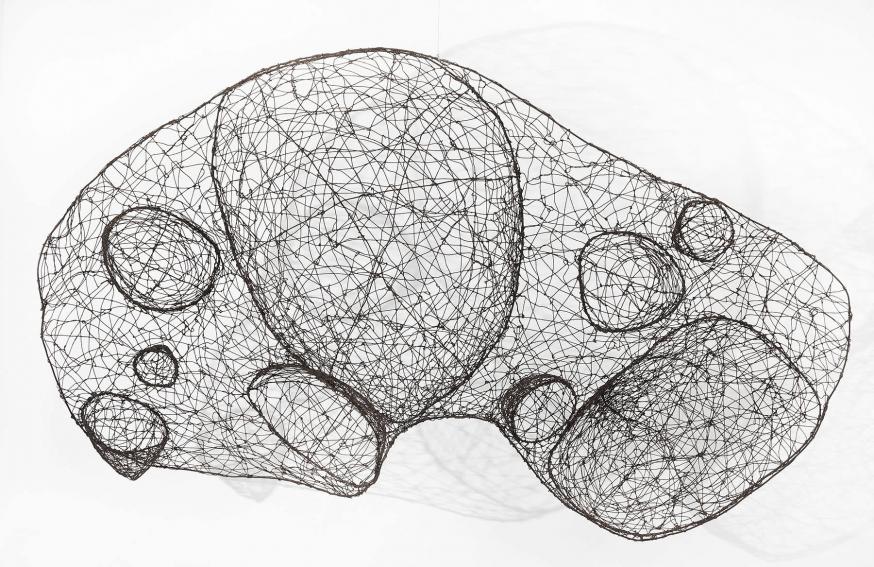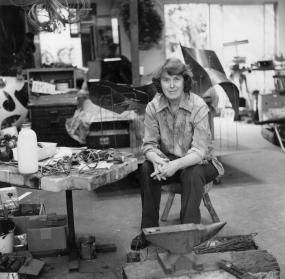Claire Falkenstein
1908–1997


Claire Falkenstein in her Venice, CA studio at 719 Ocean Avenue, 1975; Photographer unknown, Courtesy of the Claire Falkenstein Foundation
All artworks displayed above are currently available. To inquire about additional works available by this artist, please contact the gallery.
Biography
Download CVIf you look at my work and if you find any kind of rhythm or quality of continuance, it's because I've entered not only formally, but also intellectually.
A pioneering midcentury avant-garde sculptor and painter working in a range of materials including ceramic, glass, wood and metal, Claire Falkenstein (1908-1997) is known for her prolific body of work exploring the dynamism inherent to the relationship between positive and negative spaces.
Falkenstein was born in Coos Bay, a small Pacific lumber town in Oregon. As a child, she would often wake up early and ride her horse to the edge of the bay in order to watch the sun rise over the beach. This daily proximity to seaweed, shells, stones, and driftwood had a profound effect on her artistic vocabulary as an adult. Although she began sculpting as a child, Falkenstein did not intend to study art when she entered the University of California Berkeley in 1927. However, it soon became her passion, and in 1930 she graduated with a major in art and minors in philosophy and anthropology. That same year, the East-West Gallery in San Francisco mounted her first solo exhibition, a rare achievement for such a young artist. In 1933, Falkenstein received a grant to study at Mills College in Oakland with Alexander Archipenko, who introduced the principles of implied motion and spatial relationships in abstract sculpture. During her studies at Mills, she also worked with Bauhaus émigrés László Moholy-Nagy and Gyorgy Kepes.
By 1940, Falkenstein was living in San Francisco and working predominantly in wood and ceramics, creating abstract, biomorphic, three-dimensional forms with moveable parts. Her work was first shown in New York City in 1944, when the Bonestell Gallery mounted a solo exhibition. In the late 1940s, she began teaching at the California School of Fine Arts (now the San Francisco Art Institute), where she met Clyfford Still, whose abstract expressionist paintings had an important influence on her approach to sculpture, and she began to allow more room for spontaneity and accident in her compositional process. Falkenstein’s 1949 exhibition at the San Francisco Museum of Art demonstrated her move towards a freer, open-form language.
In 1950, Falkenstein moved to Paris, where her friends included American artists Sam Francis, Paul Jenkins, and Mark Tobey. Falkenstein spent most of her career unaffiliated with specific movements, and she attributes her confidence in this individuality partly to her time in Paris, explaining, “the French allowed a kind of individual action. They have the quality of centuries . . . of culture and of art and . . . [y]ou feel it within yourself when you're there. I felt it so strongly that right away my so-called "looking within" really worked. That's when I developed my own vocabulary.”[1] This vocabulary was the cornerstone of her mature style, and it consisted of five main elements: “the sign and the ensemble, the moving point and the lattice structure, the topological structure.”[2] She created some of her most important works in Europe, such as the Sun Series: sculptures of welded wire that revealed her fascination with the sculptural qualities of open and negative space. Her work was exhibited extensively, and she became the only non-German artist included in the 1952 Werkbund exhibition, revived for the first time since its suppression under the Third Reich.
Falkenstein returned to the United States in 1963, settling in Southern California, where she would remain for the rest of her life. Represented by Galerie Stadler in Paris and Martha Jackson Gallery in New York, she completed numerous public commissions around the world including the gates of the Palazzo Venier dei Leoni in Venice (now the Peggy Guggenheim Collection, Venice, Italy). Her first public commission in Los Angeles (1963-1965) was a welded copper tube and glass fountain for the California Federal Savings and Loan Association. Known as the Cal Fed Fountain, the work used water as a sculptural element integral to the composition. This work allowed Falkenstein to approach the construction of the sculpture as a flowing formal continuity, manifesting her recurring interest in molecular structure, topology, and cosmology. The largest-scale commission of her career was the redesign of the windows and doors for the St. Basil Church in Los Angeles. Completed in 1969, the series of welded doors and glass windows revolved around her notion of the “never ending screen,” a sculptural element she developed and deployed throughout her career, even incorporating it into paintings and drawings.
A prolific artist, Falkenstein continued to work and exhibit for the duration of her nearly seventy-year career. In 1997, she died at age eighty-nine and, soon after, Claire Falkenstein Foundation was created to preserve her legacy. Her work has been shown regularly in group and solo exhibitions since her death, including the 2015 exhibition Pathmakers: Women in Art, Craft & Design, Midcentury and Today at the Museum of Arts and Design in New York and the National Museum of Women in the Arts in Washington, DC. In 2016, the Peggy Guggenheim Collection in Venice mounted Omaggio a / Homage to Claire Falkenstein and the Pasadena Museum of California Art organized the traveling retrospective Beyond Sculpture, comprised of approximately seventy-five works, including sculptures, paintings, drawings, etchings, lithographs, jewelry, and watercolors, as well as large-scale photographs of her major public commissions. That same year, she was included in the group exhibition Impact: The Legacy of the Women’s Caucus for Art at the American University Museum of the Katzen Arts Center at American University in Washington, DC.
In 2017, Falkenstein’s work was featured alongside masterpieces of the 20th-century in Visionaries: Creating a Modern Guggenheim at the Solomon R. Guggenheim Museum in New York. In 2018, Claire Falkenstein: Time Elements opened at the UB Anderson Gallery of the University at Buffalo, The State University of New York. Falkenstein’s work was also featured in “Four Paintings Looking Right,” curated by Richard Prince for the exhibition Artistic License: Six Takes on the Guggenheim Collection at the Guggenheim Museum (2019) and in Venice and American Studio Glass, curated by Tina Oldknow and William Warmus, at Le Stanze del Vetro in Venice, Italy (2020).
Falkenstein’s work from her time in Paris has been featured in two recent exhibitions: United States of Abstraction: American Artists in France, 1946-1964 at the Musée d’Arts de Nantes in Nantes, France in 2021 and Americans in Paris: Artists Working in Postwar France, 1946-1962 at the Grey Art Gallery of New York University in 2023, which traveled to the Addison Gallery of American Art of Phillips Academy in Andover, MA. In 2024, Falkenstein’s legacy as a California artist was celebrated in two exhibitions: Particles and Waves: Southern California Abstraction and Science, 1945-1990 at the Palm Springs Art Museum in Palm Springs, CA, and San Francisco: The Golden Years 1930-1960, Making a Scene at the Nora Eccles Harrison Museum of Art at Utah State University in Logan, UT.
Michael Rosenfeld Gallery has consistently exhibited the work of Claire Falkenstein since 1999. In 2014, the gallery became the exclusive representative of Claire Falkenstein Foundation, mounting solo exhibitions Claire Falkenstein: A Selection of Works from 1955–1975 in 2016 and Claire Falkenstein: Matter in Motion in 2018; the latter exhibition was accompanied by a catalogue featuring an interview by Paul J. Karlstrom, former director of the Archives of American Art, and a tribute by Lynda Benglis.
Falkenstein’s diverse body of artwork is currently represented in public collections worldwide, including Addison Gallery of American Art, Phillips Academy, Andover, MA; Art Gallery of Greater Victoria, British Columbia, Canada; Art Institute of Chicago, Chicago, IL; The Baltimore Museum of Art, Baltimore, MD; Brooklyn Museum, Brooklyn, NY; Carnegie Museum of Art, Carnegie Institute, Pittsburgh, PA; Centre Georges Pompidou, Paris, France; The Cleveland Museum of Art, Cleveland, OH; Cooper Hewitt, Smithsonian Design Museum, Smithsonian Institution, New York, NY; Colby College Museum of Art, Colby College, Waterville, ME; Detroit Institute of Arts, Detroit, MI; Fine Arts Museums of San Francisco, San Francisco, CA; Fogg Museum, Harvard Art Museums, Harvard University, Cambridge, MA; Hammer Museum, University of California, Los Angeles, CA; Honolulu Museum of Art, Honolulu, HI; The Huntington Library, Art Collections, and Botanical Gardens, San Marino, CA; Los Angeles County Museum of Art, Los Angeles, CA; Museum of Arts and Design, New York, NY; Museum of Fine Arts, Boston, MA; The Museum of Modern Art, New York, NY; National Gallery of Art, Washington, DC; Norton Simon Museum, Pasadena, CA; Palm Springs Art Museum, Palm Springs, CA; Peggy Guggenheim Collection, Venice, Italy; San Diego Museum of Art, San Diego, CA; San Francisco Museum of Modern Art, San Francisco, CA; Seattle Art Museum, Seattle, WA; Smithsonian American Art Museum, Washington, DC; Solomon R. Guggenheim Museum, New York, NY; Tate Modern, London, England; Whitney Museum of American Art, New York, NY; Williams College Museum of Art, Williams College, Williamstown, MA; and Yale University Art Gallery, New Haven, CT.
[1] Oral history interview with Claire Falkenstein, 1995 Mar. 2-21, Archives of American Art, Smithsonian Institution. http://www.aaa.si.edu/collections/interviews/oral-history-interview-claire-falkenstein-12659 (Accessed July 2014).
[2] Oral history interview with Claire Falkenstein, 1995 Mar. 2-21.
Gallery Exhibitions
Press
Publications

